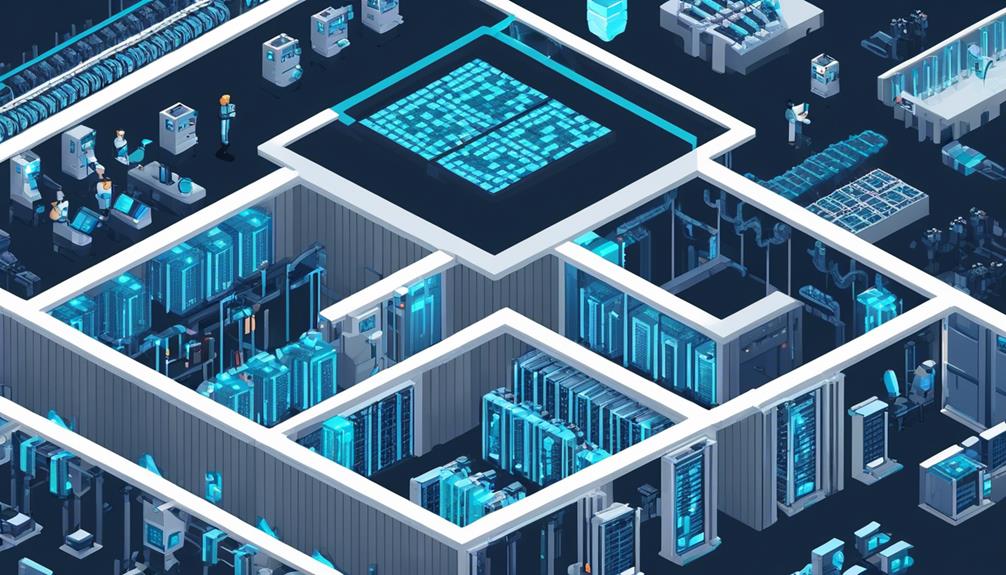In today's rapidly evolving technological landscape, the impact of artificial intelligence (AI) on data center design cannot be underestimated. AI has the potential to revolutionize the way data centers are structured and operated, leading to unprecedented levels of efficiency and performance.
This discussion will explore the various ways in which AI can optimize hardware, influence architectural decisions, and enhance overall efficiency in data centers. From cooling strategies to redundancy reduction, the integration of AI into data center design holds immense promise for the future.
By harnessing the power of AI, data center operators can unlock new possibilities and overcome the challenges of an increasingly complex digital ecosystem.
Key Takeaways
- AI-optimized hardware, such as GPUs and TPUs, enhances data center efficiency and performance by handling parallel processing and accelerating machine learning workloads.
- AI-specific data centers require efficient cooling methods like direct to cabinet and direct to chip cooling, as well as integrated mechanical and electrical solutions for sustainability.
- Efficiency optimization in data center design includes resource utilization, energy consumption reduction, and the use of AI tools for overall operational efficiency.
- Scalability and flexibility are essential in accommodating changing AI workloads, allowing for quick scaling up or down, modular designs, and easily modified data centers to adapt to new technologies and workflow changes.
AI-Optimized Hardware
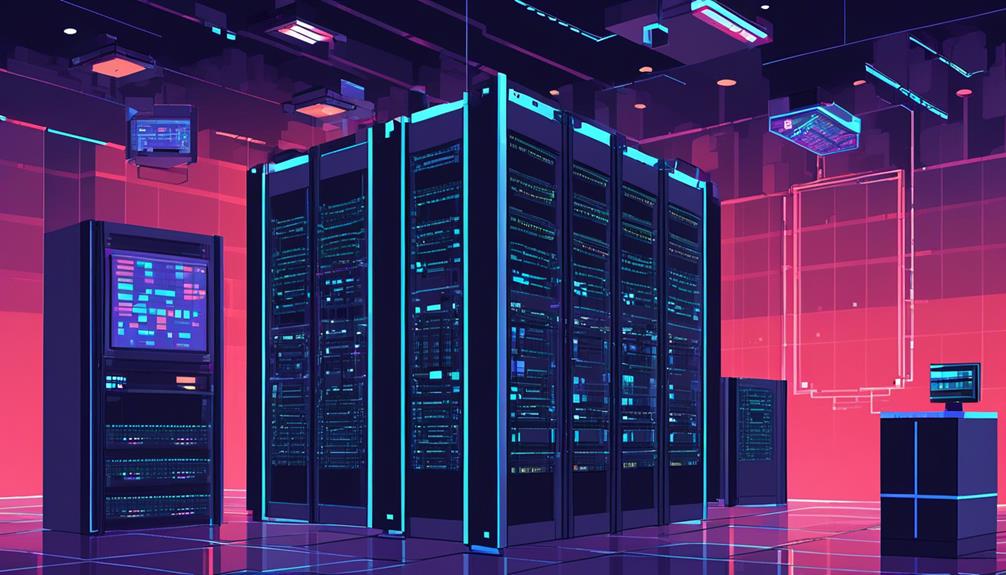
AI-optimized hardware, specifically designed to meet the unique computational requirements of artificial intelligence workloads, plays a crucial role in enhancing the capabilities and efficiency of data centers. With the exponential growth of AI applications, traditional hardware solutions are often insufficient to handle the complex tasks involved in machine learning, natural language processing, computer vision, and robotics. AI-optimized hardware, on the other hand, is tailored to efficiently process these AI tasks, offering higher computing power, lower latency, and improved energy efficiency.
One of the key components of AI-optimized hardware is the use of specialized processors such as Graphics Processing Units (GPUs) and Tensor Processing Units (TPUs). These processors are specifically designed to handle parallel processing, a crucial requirement for AI workloads. GPUs, for instance, excel at performing numerous calculations simultaneously, making them ideal for training deep neural networks. TPUs, on the other hand, are specifically designed to accelerate machine learning workloads, providing even higher performance and energy efficiency.
AI-optimized hardware also takes into consideration the unique cooling and power requirements of AI-specific data centers. The high computing power of AI workloads generates a significant amount of heat, necessitating advanced cooling solutions to maintain optimal performance and prevent hardware failures. Additionally, AI-optimized hardware is designed to minimize power consumption, making it more energy-efficient and cost-effective for data centers.
Architectural Influences
The unique computational requirements of AI workloads have not only driven the development of AI-optimized hardware but have also had a significant impact on the architectural design of data centers.
AI-specific data centers differ from traditional data centers in several ways, reflecting the specific needs of AI workloads. Firstly, AI-specific data centers have higher densities and cooling loads. To handle these increased demands, more efficient cooling methods such as direct to cabinet and direct to chip cooling are being adopted. These methods help dissipate heat more effectively, ensuring optimal performance of AI hardware.
Secondly, AI-specific data centers have fewer redundancies of equipment, varied geometry, and smaller data halls. These design choices are driven by the need for efficient cooling and lower latency requirements. By minimizing redundancies and optimizing the layout, AI-specific data centers can maximize computational power while maintaining energy efficiency.
Furthermore, the architecture of AI-specific data centers is integrating mechanical and electrical solutions, moving away from traditional concrete box designs. Emphasizing efficiency and sustainability, these data centers are incorporating innovative solutions that align with the demands of AI workloads.
Additionally, AI tools and technologies are improving the efficiency of the design process, shaping data center management and operations. With advancements in AI, there is an increased demand for data center solutions that can support AI workloads, particularly in areas such as Natural Language Processing, computer vision, and machine learning. This demand is driving the need for advanced cooling techniques in AI-specific data centers.
Design Considerations
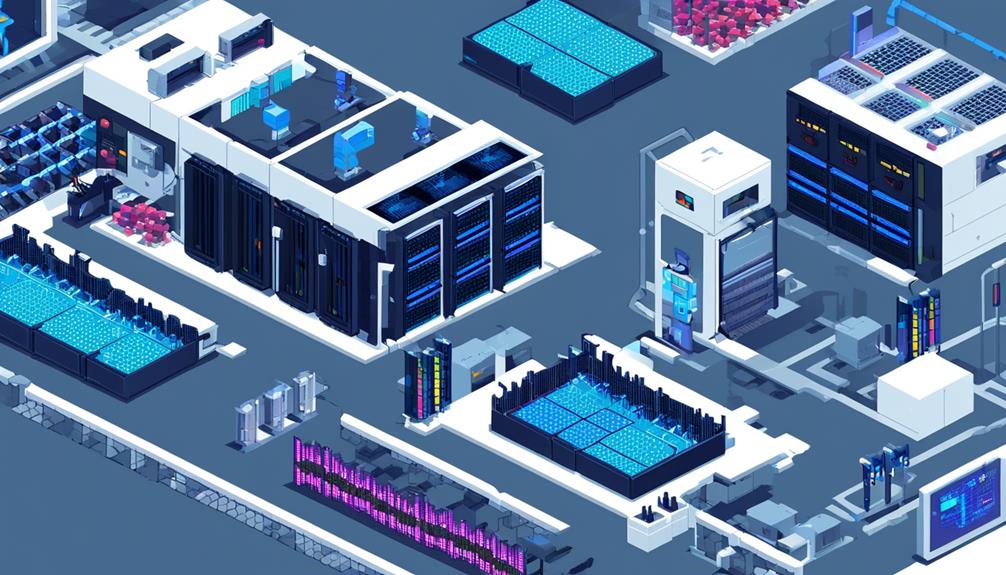
Designing AI-specific data centers requires careful consideration of efficiency optimization, scalability, and flexibility, as well as cooling and power management.
Efficiency optimization involves maximizing the utilization of resources and minimizing energy consumption.
Scalability and flexibility ensure that the data center can adapt to changing AI workloads and demands.
Cooling and power management are crucial to handle the higher densities and cooling loads of AI-specific data centers.
This requires advanced techniques to efficiently dissipate heat and manage power distribution.
These design considerations play a vital role in creating data centers that can effectively support AI technologies.
Efficiency Optimization
Efficiency optimization in AI-specific data center design demands careful consideration of cooling methods, power densities, and latency requirements.
To achieve optimal efficiency, data center designers need to focus on the following:
- Cooling methods: AI-specific data centers require direct to cabinet and direct to chip cooling methods to handle higher densities and cooling loads. These methods ensure efficient cooling and prevent overheating of the equipment.
- Power densities: With AI training workloads, data centers need to accommodate higher power densities. By designing varied geometry and reducing redundancies, designers can effectively cool these denser environments while meeting lower latency requirements.
- Integrated solutions: Integrated mechanical and electrical solutions play a crucial role in AI-specific data center design. By considering building massing and utilizing less carbon-intensive materials, designers can create more efficient and sustainable data centers.
Efficiency optimization in AI-specific data center design is essential to minimize power usage, improve performance, and reduce operational costs. Through innovative solutions and dynamic optimization, AI tools and technologies contribute to the overall efficiency of data center operations.
Scalability and Flexibility
As data centers adapt to the demands of AI-specific workloads, considerations of scalability and flexibility become paramount in guiding design decisions.
AI-specific data centers require the ability to scale up or down quickly to accommodate the rapidly changing computational requirements. Scalability ensures that the data center can handle increased workloads without compromising performance or efficiency. This involves designing infrastructure that can easily accommodate additional servers, storage, and networking equipment.
Flexibility, on the other hand, allows for the reconfiguration of the data center to meet evolving needs. It involves incorporating modular designs and flexible layouts that can be easily modified to accommodate new technologies or changes in workflow.
Cooling and Power Management
Cooling and power management are critical considerations in the design of AI-specific data centers. They must address the challenges posed by higher densities and cooling loads associated with AI workloads.
To ensure efficient cooling and power management in AI data centers, the following design considerations are essential:
- Liquid Cooling: The adoption of liquid cooling techniques, such as direct-to-chip or immersion cooling, helps dissipate the heat generated by AI servers more effectively. Liquid cooling methods offer higher cooling efficiency compared to traditional air-based cooling systems.
- Low Latency: AI workloads require low latency to deliver real-time insights and faster processing. Designing AI data centers with reduced redundancies and varied geometry allows for minimized latency, ensuring optimal performance.
- Power Management: Integrating mechanical and electrical solutions is crucial in AI-specific data center design. Emphasizing power usage effectiveness (PUE) and employing energy-efficient technologies can help reduce power consumption, enhance sustainability, and lower operational costs.
Efficiency Enhancements
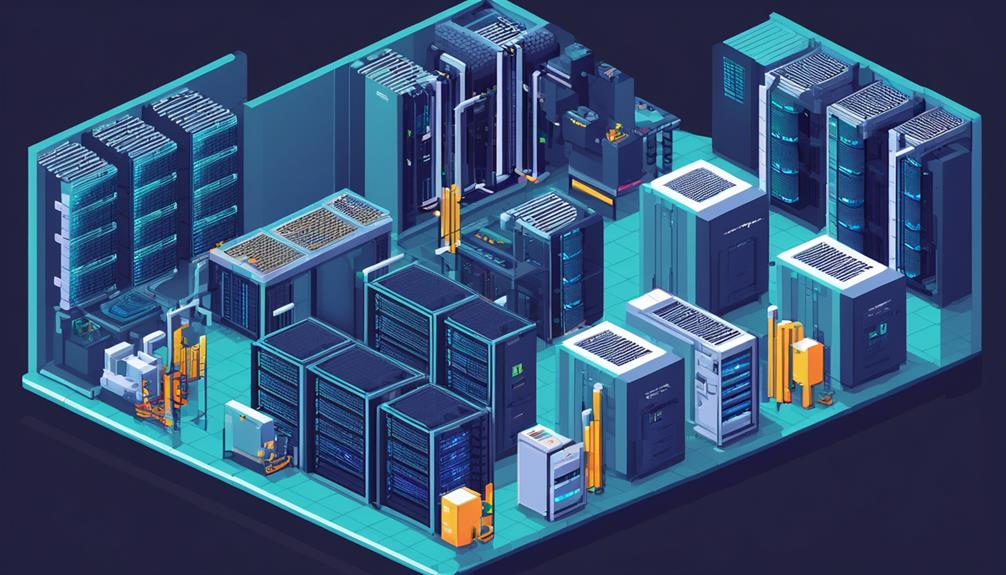
The advancements in data center design for AI-specific workloads necessitate the implementation of innovative and highly efficient cooling methods. Direct to cabinet and direct to chip cooling methods are being used in new data centers to handle the higher densities and cooling loads of AI-specific data centers. These methods allow for more targeted cooling, reducing the energy required to cool the entire data center.
Efficiency enhancements in AI-specific data centers are driven by the need for efficient cooling. AI workloads generate a significant amount of heat, and traditional data center cooling methods are often insufficient to handle the increased cooling loads. As a result, more efficient but expensive cooling methods, such as liquid cooling, are being employed. These methods provide better heat dissipation and allow for higher densities of AI hardware.
In addition to cooling, efficiency enhancements in AI-specific data centers also involve architectural and design considerations. AI and machine learning are playing a significant role in the efficiency of data center designs, impacting the architecture and building massing to improve energy efficiency. AI tools and technologies are being used to optimize the placement of equipment, minimize the distance between components, and improve airflow management.
AI-specific data centers have fewer redundancies of equipment compared to traditional data centers. They also feature smaller data halls and varied geometry to meet cooling and latency requirements driven by AI workloads. These efficiency enhancements allow for more efficient data processing and reduce the overall energy consumption of the data center.
Cooling Strategies
Utilizing innovative cooling strategies is essential in AI-specific data centers to efficiently manage the higher densities and cooling loads driven by AI workloads. Traditional means of cooling are inadequate to keep up with the growing densities, prompting the exploration of alternative cooling strategies.
Here are three key cooling strategies being implemented in AI-specific data centers:
- Direct to cabinet cooling: This method involves delivering cool air directly to the server cabinets, eliminating the need for raised floors. By bringing the cooling source closer to the heat-generating equipment, it reduces energy losses and improves cooling efficiency. This approach is particularly effective for high-density AI workloads, where heat dissipation is a significant challenge.
- Direct to chip cooling: In this approach, cooling is applied directly to the chips, ensuring optimal temperature control at the source. This technique involves using liquid cooling solutions or advanced air-cooling techniques, such as direct liquid cooling or immersion cooling. By efficiently removing heat at the chip level, it enables higher power densities and reduces the risk of thermal throttling, thereby maximizing the performance of AI workloads.
- Integrated architectural design: The integration of mechanical and electrical solutions with the architectural design of data centers is becoming crucial in AI-specific facilities. This includes designing airflow management systems, hot and cold aisle containment, and efficient distribution of cooling resources. By incorporating cooling strategies into the overall design, data centers can achieve better cooling efficiency, energy savings, and improved thermal management for AI workloads.
Implementing these cooling strategies in AI-specific data centers not only ensures optimal performance but also reduces energy consumption and operational costs. As AI workloads continue to grow, the impact on data centers necessitates the adoption of innovative cooling solutions to meet the increasing demands for computational power and thermal management.
Redundancy Reduction
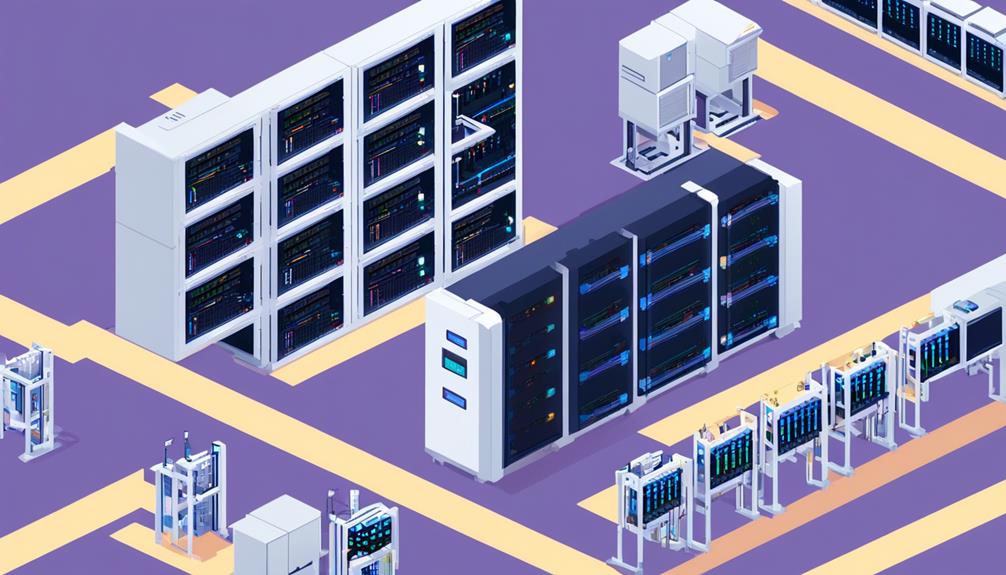
With the focus on optimizing efficiency and reducing operational costs in AI-specific data centers, the trend of redundancy reduction emerges as a strategic design approach. Redundancy reduction in AI-specific data centers results in fewer redundancies of equipment compared to traditional data centers. This approach is driven by the need for efficient cooling and lower latency requirements.
One key aspect of redundancy reduction is the reduction in the number of racks per row and smaller data halls. This leads to a more compact and efficient layout, allowing for better utilization of space and resources. The sizes and geometry of AI-specific data centers become more varied as a result, enabling flexibility in accommodating different equipment and configurations.
To illustrate the impact of redundancy reduction in AI-specific data centers, let's take a look at the following table:
| Design Aspect | Traditional Data Centers | AI-Specific Data Centers |
|---|---|---|
| Racks per Row | 10 | 6 |
| Data Hall Size | Large | Small |
| Equipment Redundancy | High | Low |
As shown in the table, AI-specific data centers have fewer racks per row and smaller data halls compared to traditional data centers. This reduction in equipment redundancies allows for more efficient cooling and lower latency, which are critical factors in AI operations.
The trend of redundancy reduction in AI-specific data centers also influences the criteria for selecting ideal sites. Proximity to major data hubs and network connectivity becomes more important to ensure low latency and efficient data processing.
Integrated Infrastructure
AI-specific data centers are characterized by their integrated infrastructure, which encompasses advanced cooling methods and the incorporation of building architecture into mechanical and electrical solutions. These advancements are driven by the increasing demand for efficient and powerful data centers to support AI workloads, such as AI training and Natural Language Processing.
- Advanced Cooling Methods: AI-specific data centers employ innovative cooling techniques to manage the high heat generated by AI workloads. Direct to cabinet and direct to chip cooling methods are commonly used. Direct to cabinet cooling involves delivering cool air directly to the server cabinets, while direct to chip cooling focuses on cooling the individual chips within the servers. These methods improve cooling efficiency and reduce energy consumption, ensuring optimal performance and reliability.
- Building Architecture Integration: The design of AI-specific data centers incorporates the building architecture into the mechanical and electrical solutions. This integration allows for efficient utilization of space, reduced energy consumption, and improved overall performance. The architecture is carefully considered to optimize airflow, reduce hotspots, and enhance cooling effectiveness. The incorporation of building architecture into the data center design enables a seamless integration of technology and infrastructure.
- Efficiency and Scalability: AI tools and technologies are continuously evolving, driving the need for integrated infrastructure in data centers. The design of AI-specific data centers focuses on reducing redundancies of equipment, utilizing varied geometry, and implementing smaller data halls compared to traditional data centers. This approach enhances efficiency, reduces costs, and allows for easier scalability to accommodate the growing demands of AI workloads.
Frequently Asked Questions
How Does Artificial Intelligence Affect Design?
Artificial intelligence (AI) has a profound impact on design across various disciplines.
In architectural design, AI-powered tools enhance efficiency and accuracy, allowing architects to generate complex designs with ease.
AI also plays a crucial role in user experience design, analyzing user behavior and preferences to create personalized and intuitive interfaces.
Additionally, AI enables sustainable design by optimizing energy consumption and reducing waste.
The integration of AI in design processes revolutionizes the industry, enhancing creativity, precision, and sustainability.
What Is the Difference Between Traditional Data Center and AI Data Center?
AI data centers differ from traditional data centers in several key aspects.
AI data centers have specific features designed to optimize the infrastructure for AI workloads, including higher densities and cooling loads, as well as advanced cooling methods. These data centers also have fewer redundancies, smaller data halls, and varied geometry to meet the demands of AI workloads.
The architecture of AI data centers integrates mechanical and electrical solutions to emphasize efficiency and sustainability.
What Is the Impact of AI on Data Science?
The impact of AI on data science is significant and far-reaching. AI applications in data science have revolutionized the field by enabling advanced data analytics, driving data modeling techniques, and enhancing data-driven decision making.
AI-powered algorithms and models have the ability to process and analyze vast amounts of data, extracting valuable insights and patterns that were previously inaccessible. This has led to improved accuracy, efficiency, and scalability in data science, empowering organizations to make more informed and impactful decisions based on data-driven insights.
What Is Data Center in Artificial Intelligence?
A data center in the context of artificial intelligence refers to a facility that houses the infrastructure necessary to support AI computing power and requirements. It is designed to optimize the performance and efficiency of AI workloads, which often demand high computational power and generate significant heat.
To meet these demands, data centers for AI incorporate advanced cooling techniques and efficient designs. The integration of AI tools and technologies in the design process further enhances the efficiency and effectiveness of data center operations.
